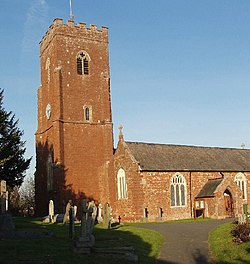Exminster
| Exminster | |
| Devon | |
|---|---|
 St Martin's Church, Exminster | |
| Location | |
| Grid reference: | SX944875 |
| Location: | 50°40’41"N, 3°29’45"W |
| Data | |
| Postcode: | EX6 |
| Local Government | |
Exminster is a village in south-eastern Devon, on the southern edge of the City of Exeter on the western side of the Exeter ship canal and River Exe. It is around 4 miles south of the centre of Exeter, and had a recorded population of 3,084 at the 2001 census.
Exminster is an ancient village associated with a Saxon minster or monastery, founded here in the 8th Century, and which gave the village its name.
In the 14th Century, Exminster was the seat of the Courtenay family, the Earls of Devon. William Courtenay, who was the Archbishop of Canterbury from 1381 to 1396, was born here.[1]
Exminster Marshes, to the east of the village, are a major site for birds, especially migratory ones[2] including the rare Cirl Bunting.[3]
Parish church
The present parish church of Saint Martin of Tours is a Grade I listed building and was built in the late 14th and 15th centuries in the Perpendicular style. It was heavily restored in 1841 and again in 1852. It has a large three-storied tower with a polygonal stair turret. Inside, the Peamore chapel has a plaster ceiling dated 1633, depicting the Twelve Apostles and the Four Evangelists, scenes of the Nativity, Christ carrying the cross and the Resurrection. There is also a notable monument to Otho Petre of Bowhay who died in 1607.[4]
The churchyard contains the war graves of eight British servicemen of the First World War, of whom the first and most senior is Major General Robert Kekewich,[5] - and three of Second World War.[6]

Sights of the village
On a hill overlooking the Exe estuary at the north-west side of the village is the former Devon County Asylum, a lunatic asylum designed by Charles Fowler and opened in July 1845. It featured a central administration block with six radiating arms and had a capacity of around 800 beds. The hospital closed in the mid-1980s when it was known as Exminster Hospital.[7] After years of neglect, the surrounding land was developed for housing and the Grade II listed hospital was converted to apartments and town houses; it is now known as Devington Park.

Exminster railway station was opened by George Hennet on behalf of the South Devon Railway in 1852. It closed to passenger traffic on 30 March 1964 and to goods on 4 December 1967, but its distinctive building still stands next to the railway line. The signal box remained standing on the site until September 2006 but has now been removed for preservation to Broadway, Worcestershire.[8]
Economy
Exminster's amenities include a surgery, pharmacy, a village shop, a convenience store, several estate agents, a golf course, a hairdresser, as well as a community facility (The Westbank) which incorporates a gym, an IT suite with web access, and daytime family and toddlers' groups. Exminster also has a primary school; several parks for children including a skate park; and three pubs – The Stowey Arms, The Royal Oak and The Swan's Nest. The Topsham and Exminster Brewery, which produces Ferryman Ale, is located at a former RAF GCI (Ground Controlled Interception) radar station in the midst of the Exminster Marshes RSPB reserve.
The Exeter Canal cycle path leads from Exminster into the centre of Exeter, giving commuters in the village a traffic-free route into the city.[9]

Outside links
| ("Wikimedia Commons" has material about Exminster) |
- Exminster.net
- Exminster in the Domesday Book
References
- ↑ [1]
- ↑ BBC Devon article. Retrieved on 18 May 2007
- ↑ BBC Devon article. Retrieved on 18 May 2007.
- ↑ Exminster - British Listed Buildings
- ↑ [2] CWGC Casualty Record.
- ↑ [3] CWGC Cemetery Report, details obtained from casualty record.
- ↑ Index of Lunatic Asylums and Mental Hospitals. Retrieved on 18 May 2007
- ↑ Broadway signal box website. Retrieved on 18 May 2007
- ↑ Local map of cycling route between Exminster and Exeter